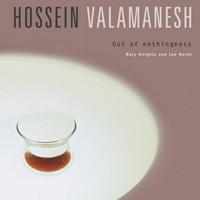Often described as poetic and finely balanced, Valamanesch’s work arranges natural elements – branches, seeds, foliage, bark, wood, earth, ladders and found objects from domestic life – in refined, frequently rectilinear compositions. There is a high degree of finish and neatness that can sometimes deflect the actual latent emotional content inside. There are important recurrent motifs: a burning candle, empty shoes, cast shadows, shirts that evoke the departed, the disappeared and transience of emphemerality. His corpus is infused with gentle humanity. Artists who have followed his career speak of each new show being like an episode for a major epic poem cycle, part of a continuous whole. The last image in this book, a picture of the artist as an infant sitting upright supported by his mother’s hands, is described, self-referentially I think, as a “work in progress”.
The last major survey of Valamanesch’s work (Tracing the Shadow) was at Sydney’s Museum of Contemporary Art in 2002. Redressing this relative anonymity, Wakefield Press, working with the SALA (South Australian Living Artists) Board (itself underwritten by the SA government) has published a handsome and meticulously produced monograph co-authored by Mary Knights and Ian North. Running some 176 pages in full colour, Hossein Valamanesh: Out of nothingness goes some way to broadening the appreciation of the artist’s work.
For authors Knights and North this book seems a labour of love. Knights is director of the SASA (South Australian School of Art) Gallery at the University of South Australia. North, also SA based, is a writer, curator and artist. Both have a long standing interest in Valamanesh’s work.
Valmamanesh was born in Tehran in 1949 and had already commenced training as an artist when he emigrated to Australia in 1973. Here, he continued studies at Adelaide’s SASA, graduating in 1977. Most widely known for his sculpture, Valamanesh has also created theatrical stagings and photography.
The book in arranged into two galleries of images preceded by an ‘interview’ complied from multiple sources by North and a bibliographic essay by Knights. While North has arranged his compilation to reflect main themes and influence in Valamanesh’s ouvre – Theatricality, Early influences and multiculturalism, Aboriginality, collaboration with his artist partner Angela, and Metaphysical Moments – I think it better to read Knight’s essay first, as its straightforward chronological biographical approach is informative and concise. North’s compilation, which stems from a very long and deep association with the artist, is more meaningful after you have developed a framework from reading Knights.
We learn of a young artist who emigrated in the period of corrupt turmoil that preceded the fall of the Shah and the ascent of a repressive theocracy. A book of poetry by the Sufi author Rumi carried with him remained a life-long influence. Formative contact with Indigenous Warburton and Papunya painters and encouragement to tell his own story. A dot painting made of medication following his heart attack in 1995 (Dot painting with tablets, 1997). A Persian carpet burnt-out in the centre by a nomadic fire (Longing Belonging, 1997). The creative partnership with his wife Angela. Fingerprints. Farsi script.
In many ways it is a great pity that this excellent monograph is not accompanying a major retrospective. Valamanesh’s work is evocative and begs encounter. While the colour reproductions are excellent the strength of this book it that it makes you long to know the artist better.
Rating: Four stars
Hossein Valamanesh: Out of nothingness
By Mary Knights and Ian North
Wakefield Press
ISBN 9781743050057
Hardback, 176 pages
AU$49.95 including GST





